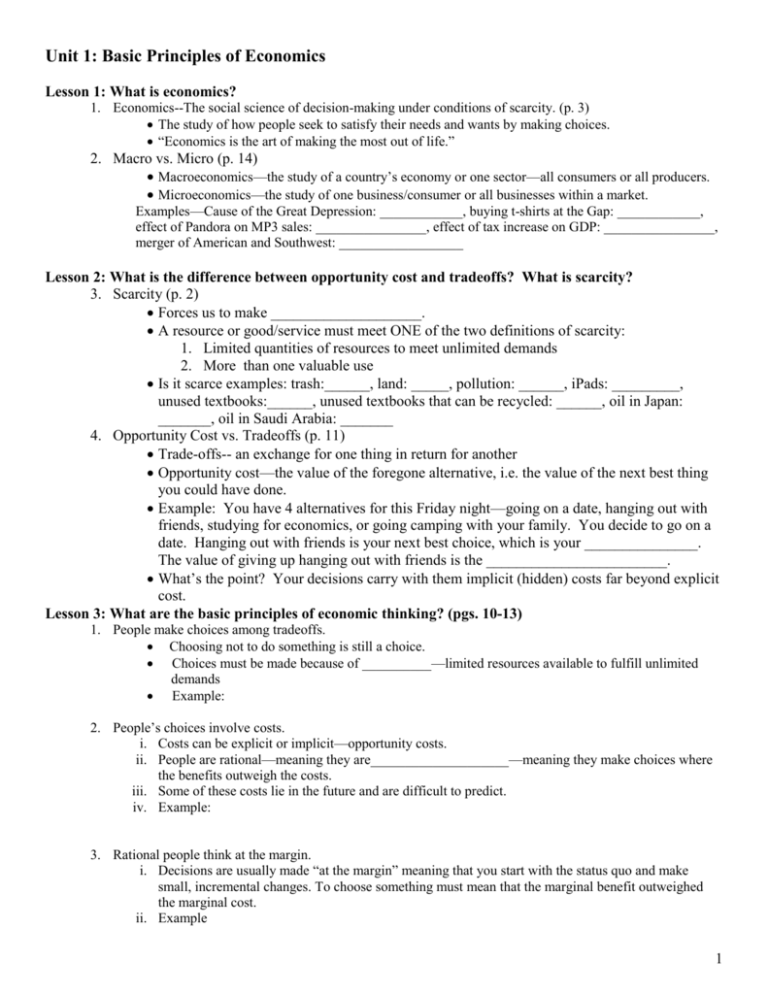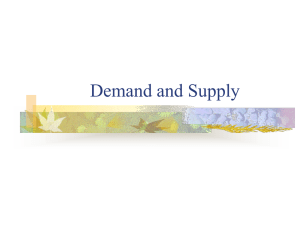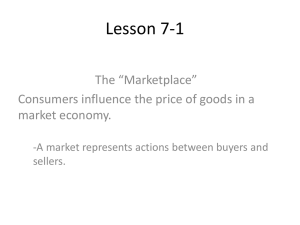Unit 1 Notes
advertisement

Unit 1: Basic Principles of Economics Lesson 1: What is economics? 1. Economics--The social science of decision-making under conditions of scarcity. (p. 3) The study of how people seek to satisfy their needs and wants by making choices. “Economics is the art of making the most out of life.” 2. Macro vs. Micro (p. 14) Macroeconomics—the study of a country’s economy or one sector—all consumers or all producers. Microeconomics—the study of one business/consumer or all businesses within a market. Examples—Cause of the Great Depression: ____________, buying t-shirts at the Gap: ____________, effect of Pandora on MP3 sales: ________________, effect of tax increase on GDP: ________________, merger of American and Southwest: __________________ Lesson 2: What is the difference between opportunity cost and tradeoffs? What is scarcity? 3. Scarcity (p. 2) Forces us to make ____________________. A resource or good/service must meet ONE of the two definitions of scarcity: 1. Limited quantities of resources to meet unlimited demands 2. More than one valuable use Is it scarce examples: trash:______, land: _____, pollution: ______, iPads: _________, unused textbooks:______, unused textbooks that can be recycled: ______, oil in Japan: _______, oil in Saudi Arabia: _______ 4. Opportunity Cost vs. Tradeoffs (p. 11) Trade-offs-- an exchange for one thing in return for another Opportunity cost—the value of the foregone alternative, i.e. the value of the next best thing you could have done. Example: You have 4 alternatives for this Friday night—going on a date, hanging out with friends, studying for economics, or going camping with your family. You decide to go on a date. Hanging out with friends is your next best choice, which is your _______________. The value of giving up hanging out with friends is the ________________________. What’s the point? Your decisions carry with them implicit (hidden) costs far beyond explicit cost. Lesson 3: What are the basic principles of economic thinking? (pgs. 10-13) 1. People make choices among tradeoffs. Choosing not to do something is still a choice. Choices must be made because of __________—limited resources available to fulfill unlimited demands Example: 2. People’s choices involve costs. i. Costs can be explicit or implicit—opportunity costs. ii. People are rational—meaning they are____________________—meaning they make choices where the benefits outweigh the costs. iii. Some of these costs lie in the future and are difficult to predict. iv. Example: 3. Rational people think at the margin. i. Decisions are usually made “at the margin” meaning that you start with the status quo and make small, incremental changes. To choose something must mean that the marginal benefit outweighed the marginal cost. ii. Example 1 4. People respond predictably to incentives—rewards. i. Economists and policy makers can manipulate the incentive to manipulate behavior. ii. Example: 5. People gain when they trade voluntarily. i. Free trade internally (within a country, with your neighbors) and externally (with other countries) benefits everyone. ii. Example: Lesson 4: What are the four major factors of production, and how do they relate to income? (pg. 36-39) 1. 2. 3. Factors of production= a.k.a. resources—these are scarce. Land—natural resources, Examples: ___________=income from land resources Labor—paid human effort, Examples: ___________=income from labor resources Capital Physical capital—man-made resources that are used to produce other goods. Examples: Human capital—education for the job Examples: 4. ___________=income from capital resources Investment in physical and human capital increase future ____________. NOT ______________capital, stocks, bonds, money Entrepreneurship—risk taker and combines the other resources to make a good or service, Examples: __________= income from entrepreneurship Lesson 5: How do different types of economic systems seek to answer the three basic economic questions? (pg. 3-4) Organized way to produce and distribute g/s Answers 3 Basic economic questions: o ________ to produce? o ________ to produce it? o ________gets it? Three Major Types o Market—forces of supply and demand answer the 3 basic Qs, self-interest motivates, competition regulates Examples: The Good—flexible, freedom, variety of g/s, growth The Bad—inequitable, market failures o Command—government answers the 3 basic Qs Examples: The Good—can change drastically fast, may provide for basic necessities The Bad—Lacks incentives for hard work, costly to plan, inflexible for small stuff o Traditional—the past answers the 3 basic Qs Examples: The Good--Life is predictable, closer to family and community The Bad—no growth, low standard of living, discourage new ideas All economies are a mixture of the above--some more market, some more command. U.S. is the ____ most market. N.Korea is the most command. 2 1 2 3 4 5 10 8 0 6 Squares Triangles Lesson 6: How does the production possibilities curve demonstrate opportunity cost, growth, and efficiency? (pgs. 62-73, 79) 2 4 Triangles 1 2 3 4 5 Squares PPC—shows the alternative ways of using resources to produce the maximum amount of goods and services. Demonstrates ______________ costs. If you increase production of triangles, then you must give up some production of squares. What is the opportunity cost of producing one square? _____________ What is the opportunity cost of producing one triangle? ______________ _________________ Opportunity Cost—graph above, opportunity costs stay the same, the production of each additional square costs two triangles, if opportunity costs are constant, then resources are easily convertible— easy to make 2 triangles out of one square. ___________________ Opportunity Costs—graph on bottom, opportunity costs increase (for BOTH goods) as you produce more of one good. For example, as you produce more pizzas it costs more robots. The 1st pizza only cost ____robot; when going from point D to point E, the 4th pizza costs_____ robots. This is because the resources are not easily convertible. MOST COMMON, Also shows efficiency/inefficiency, full employment/unemployment, growth, and unattainable points. o All points along the curve are _______________ efficient—making the most goods/services possible. _________________ efficiency—type of efficiency where the right mix of g/s is produced. Shown on only one point on the graph. You will not know which point this is unless other information is provided. o Points _____________ the curve are attainable but inefficient. Resources are not fully utilized. Ex. there is unemployment, discrimination (people discriminated against are not being fully utilized), factories not operating at full capacity. o Points _______________ the curve are unattainable with current resources unless the production possibilities curve shifts outward. Production Possibility Curve Shifts o o Shifts ___________ if more resources or improved productivity Shifts ____________ if resources are lost—ex. global warming causes all coastal land to flood 10 miles into the US. o If you produce more physical capital goods, then PPC will shift out more because physical capital goods are a resource, more resources=more growth. 5. 6. 7. 3 Lesson 7: How do you compute comparative advantage and terms of trade? (pgs. 81-84) Theory that demonstrates the benefits of specialization and trade. _____________ Advantage—the ability to make more stuff with the same amount of resources. _____________ Advantage—the ability to make stuff with the least amount of opportunity cost. Finding Comparative Advantage—Output Problems o Output problems=number of goods/services produced o Input problems=amount of time or other resources used to produce. Always put the actors in this column Betty Dishwashing Sweeping 2 (3/2=1.5) 3 (2/3) Bert 1 (1) 1 (1) Step 1: Set up the problem correctly in the above table. Step 2: Find the opportunity cost for each person and task. For output problems ONLY—put the opposite number on top and reduce the fraction (if needed) Put the opportunity cost in parentheses Step 3: Find who has the comparative advantage by looking at who has the lowest opportunity cost for each task. Who has the comparative advantage in dishwashing? o Look at the dishwashing column o See who has the lowest number as the opportunity cost. o Do the same for the other good/service The stuff can be shown on a graph or a table. Must be able to read both. To read the table or graph the easiest approach is to look at the highest numbers. Mexico can produce 60 avocados OR 15 soybeans, the US can produce 90 avocados OR 30 soybeans. Who has the absolute advantage in avocados? ___________ Who has the absolute advantage in soybeans? ___________ 75 60 Un ite d 45 es at St Me o 30 xi c 15 Avocados 90 If on a graph, whichever country’s PPC is on the right, it has the absolute advantage. The comparative advantage must be computed. 5 10 15 20 25 30 Soybeans Work the avocado/soybean problem in the box above. 1. Who has the comparative advantage in avocados? ___________ 2. Who has the comparative advantage in soybeans? ___________ Importing and exporting—Whoever is producing the product will be ____________ it. You _____________a product if you allow another country to produce it for you. ____________ will be exporting and __________ will be importing avocados ____________ will be exporting and __________ will be importing soybeans 4 Terms of Trade Sometimes problems will ask about what terms of trade (price per good) would be beneficial to both nations. For example—In order to be beneficial to both nations what should the terms of trade be for 1 avocado ? The easiest thing to do is to look at the column for avocados and place the terms of trade as in between the two opp cost. 1 avocado for more than ____of a soybean but less than _____of a soybean. REMEMBER—the seller always benefits from a ___________ price and the buyer benefits from a ___________ lower price. Mexico is selling avocados. It would benefit as long as the price is HIGHER than ¼ a soybean. The US can make 1 avocado for the cost of 1/3rd a soybean, so they only benefit if the price is LESS than 1/3rd. What terms of trade would be beneficial to both nations for 1 soybean? _________ Who would benefit if the terms of trade were 1 soybean for 5 avocados? _________ Input Problems Not looking at how much the person (country) can produce, but how much resources it takes to produce the same good. Absolute advantage o Who has the lower number? o Why? Because it takes him/her less resources. Comparative advantage o Set up the same way o EXCEPT switch the order to find the opp. cost—put the same number on top. Joe can produce a salad OR a smoothie in only two minutes, but his new trainee Liz takes much longer to produce salads—10 minutes. However, she has worked on her smoothie skills and can turn one out in the same time as Joe. Absolute advantage in smoothies? _______ Joe Salads (in minutes) 2 (1) Comparative advantage in salads? _______ Liz 10 Absolute advantage in salads? __________ (5) Smoothies (in minutes) 2 (1) 2 (1/5) Comparative advantage in smoothies? ____ Work the following problem. Assume that: the US can produce a car in 16 minutes; Japan can produce one in 14 minutes; the US can produce a computer in 12 minutes; Japan can produce one in 8 minutes. Absolute advantage in cars? ________________ Absolute advantage in computers? ___________ Comparative advantage in cars? _____________ (in minutes) (in minutes) Comparative advantage in computers? __________ Terms of trade advantageous to both? ___________ Winners and Losers of Free Trade o Who wins? o Who loses? 5 Lesson 8: What is a market? How do the forces of supply and demand work in a market? What is a market? Any arrangement that brings buyers and sellers together. The buyers create ____________. The sellers create ____________. Who sets the price in a competitive market? ___________________________ How does competition help consumers? ___________________________________________________ The market is ruled by the forces of SUPPLY and DEMAND. Law of supply—as prices ________________, the QUANTITY supplied ________________ OR as prices_________________, the QUANTITY supplied ____________________. o This is a _______________ relationship. On a graph, the sUPply line goes ______. Law of demand—as prices _______________, the QUANTITY demanded _______________ OR as prices ________________, the QUANTITY demanded ____________________. o On a graph, the Demand _____________________. Lesson 9: What is the difference between a change in demand and a change in quantity demanded? Be able to graphically apply the determinants of demand. (pgs. 91-96) Demand—1. _____________ to own 2. ability and willingness to __________ Law of Demand—as prices increase, quantity demanded decreases; as prices decrease quantity demand increases. 3 Reasons that explain the slope of the demand curve Income Effect—when the price of a good goes down, your money will buy more; therefore, it has the effect of increasing your real income Substitution Effect—If prices go up, the quantity demanded will go down b/c you will begin to buy substitutes. Diminishing Marginal Utility—each additional (marginal) unit purchased will give you less utility (satisfaction). Therefore, the only way I will buy more is if the producer lowers the price. Science of Economics (pg. 15) 2.00 $2.00 0 1.00 Quantity $1.50 1 .50 Price 1.50 Price _____________Economics—what is, statements of fact* economist most interested in _____________ Economics—what should be, statements of opinion Examples: “The number of farms has decreased over the last 50 years.” P or N “The poor pay too much for housing.” P or N “If income decreases the demand for most goods will decrease.” P or N Ceteris Paribus-- a Latin phrase that means all variables other than the ones being studied are assumed to be constant. “All other things being ____________” Tools to Show Demand Demand Schedule—a ____________ that lists the various quantities demanders will purchase at various prices. Demand Curve—schedule in __________ form Demand for Pizza Individual—one person’s demand for a product Market—a group’s demand for a product $1.00 2 $0.50 3 1 2 3 4 Quantity 6 Difference between QUANTITY DEMAND and DEMAND Quantity Demanded—ONE quantity at ONE price Demand—List of quantities at different prices illustrated by a demand schedule and a demand curve. Change in QUANTITY demanded o ________________ along the demand curve o Caused by a change in the _________ of the product Change in DEMAND o __________ of the entire curve o Caused by one of the_______________ of demand Changes in Demand Shifts the curve LEFT or RIGHT, NOT up or down If demand INCREASES, the demand curve shifts to the _____________ If demand DECREASES, the demand curve shifts to the ____________ Determinants of Demand o T--taste and preferences—events, new technology, more information Example: o R—related goods substitutes—if the price of a substitute goes up, then the demand for the original good will ______________, direct relationship Example: complements—if the price of a complementary good increases, then the demand for the original good will _____________, an inverse relationship Example: o I—income Normal goods—assume normal unless otherwise stated or unless it is a known inferior good (ramen/off-brand names); if income ↑, then demand ↑, vice versa Inferior goods—if income ↑, then demand ↓. o B—number of buyers—if the population that demands a particular product increases, then demand increases Example: o E—expectations—if people expect a shortage, then buy today; if people expect a sale tomorrow, then demand less today—Demand is always for the current time period (today) unless otherwise stated. Example: 2.00 1.50 Price 2.00 What happened to the equilibrium price? _________ 1.00 1.50 1.00 DECREASE in DEMAND D 1 2 3 4 Quantity D .50 INCREASE in DEMAND Demand for Pizza D1 .50 What happened to the equilibrium quantity? _______ Demand for Pizza Price What happened to the equilibrium price? _________ D1 1 2 3 What happened to the equilibrium quantity? _______ 4 Quantity 7 Lesson 10: What is the difference between a change in supply and a change in quantity supplied? Be able to graphically apply the determinants of supply. (pgs. 98-103) Supply of Pizza 2.00 Price 1.50 1.00 .50 O—other goods—if the price of another good that the producer sells has gone up, then supply will decrease for the other good. Example: T—Taxes (government) also deals with subsidies—helps businesses, if the government offers a tax credit for businesses then supply increases, if they eliminate a tax credit for businesses then supply decreases Example: T—Technology Example: E—Expectations—if supplier expects prices to rise in the future, then will cut back supply today. Example: N—number of sellers Example: S1 S What happened to the equilibrium price? _________ 1.00 1.50 S1 2.00 Market for Pizza D 1 2 3 4 Quantity INCREASE IN SUPPLY .50 What happened to the equilibrium quantity? _______ Market for Pizza S Price What happened to the equilibrium price? _________ 2.00 Price 1.50 1.00 S Supply—amount produced for sale. Law of Supply—as prices increase, quantity supplied increases; as prices decrease, quantity supplied decrease. Individual and Market Supply Schedule and Curve Change in quantity supplied—movement along the curve, caused by a change in ______________ 1 2 3 4 Change in supply—shifts the curve, brought about by determinants of Quantity (per slice, in hundreds) supply o Shift to the right=______________ o Shift to the left=_______________ Determinants of Supply R—resource costs—if the costs to make the good increases, then producers will not be able to produce as much. Example: .50 D 1 2 3 What happened to the equilibrium quantity? _______ 4 Quantity DECREASE IN SUPPLY 8 Lesson 11: How does price and quantity change when the equilibrium changes? What happens when the market is in disequilbrium? (pgs. 105-111) Equilibrium: Quantity Demand=Quantity Supplied, Happy Place! Equilibrium changes when demand and/or supply shifts (see examples above) What happens to EP and EQ when both demand and supply shift at the same time????? Shift both curves by the same amount. Either price or quantity will always change, the other will always be indeterminate, unless you know exactly how much each curve shifted by. o In this case, I increased both supply and demand, which caused there to be an increase in quantity and an indeterminate change in price. .50 1.00 1.50 Price 2.00 Increasing Both D and S 1 2 3 Quantity 4 (per slice, in hundreds) Disequilibrium 2.00 Price Floor=Shortage 1.50 1.00 QS and QD do NOT equal A competitive market will self-correct to get back to equilibrium Shortage: quantity demanded > than quantity supplied Seller will _________ the price until it reaches equilibrium Surplus: quantity supplied > than quantity demanded Seller will _________ the price until it reaches equilibrium Sometimes the government sets prices above and below the market price for equity reasons. __________—maximum price the seller can charge, Helps consumers, Causes a shortage, Ex. rent control apartments __________—minimum price that the seller can charge, Helps suppliers, Causes a surplus, Ex. agricultural goods, minimum wage in the labor market Calculate the shortage/surplus by finding the difference between the quantity demanded and quantity supplied at the given price. At $1.75—the surplus is 2: 4 (QS) – 2 (QD) Supply of Pizza S Price Ceiling=Shortage .50 Price Draw above a decrease in D and an increase in S. What happened to EP? ________ What happened to EQ? _________ D 1 2 3 Quantity 4 (per slice, in hundreds) 9







